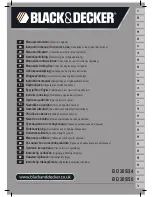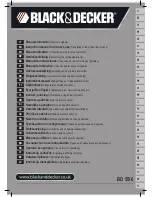
17
2.4 MOTOR PROTECTION DEVICES
The compressors are equipped with an amperometric
thermal breaker with manual reset, located outside the
terminal board cover. When a thermal trip occurs, wait
a few minutes and then reset the RESET switch
(10)
manually.
If the protection device trips again at the subsequent
restart, is is highly recommended stop the compres-
sor, disconnect the power supply and contact an
authorised service centre.
2.5 ADJUSTING THE OPERATING PRESSURE
It is not always necessary to use the maximum pressure.
Most of the time pneumatic tools work at a lower pres-
sure. Always check the correct operating pressure of the
tool you intend to use.
In compressors supplied with a pressure reducer
(6)
,
operating pressure must be correctly adjusted. Adjust
the pressure to the desired value by turning the knob
clockwise to increase it and anti-clockwise to decrease
it. When the desired pressure is reached (which you
can check on the pressure gauge
7
), lock the knob by
pressing it downwards.
If there is no pressure reducer on the machine, the user
must fit suitable means for intercepting and reducing
the pressure on the distribution line.
2.6 CAUTIONS WHILE USING
• Do not unscrew any connection while the tank is pres-
surise. Always make sure the tank is pressure free.
• Do not drill holes, weld or purposely deform the com-
pressed air tank.
• Do not carry out any work on the compressor without
first unplugging it from the wall outlet.
• Recommended ambient operating temperature 0°C
+35°C
• Do not direct jets of water or flammable liquids onto
the compressor.
• Do not place flammable objects near the compressor.
• During downtimes, turn the pressure switch to posi-
tion “0” (OFF)
• Never direct the air jet towards people or animals.
• Do not transport the compressor with the tank under
pressure.
• Please note that some parts of the compressor such
as the compressor head and delivery pipes can reach
high temperatures. Do not touch these components to
avoid burns.
• Transport the compressor, lifting or pulling it with the
appropriate grips or handles.
• Keep children and animals well away from the ma-
chine operating area.
• If using the compressor for painting:
a) Do not work in closed environments or near to
naked flames
b) Make sure there is adequate air exchange in the
environment where you are operating
c) Protect the nose and mouth with a mask.
• If the power cord or plug is damaged, do not use the
compressor. Please contact your authorised service
centre to replace it with an original part.
• Do not insert objects and/or hands inside the protec-
tion grilles.
• Always unplug the plug from the wall outlet after use.
BEFORE CARRYING OUT ANY WORK ON THE COMPRES-
SOR, MAKE SURE OF THE FOLLOWING:
• The master power switch is in position “0”.
• The pressure switch and/or switches on the control
unit are switched off (position “0/Off”).
• The air tank is NOT under pressure.
• On models where the fairing has to be removed in
order to access the internal parts, make sure you do
not pull cables or connections.
3.1 CLEANING/REPLACING THE SUCTION FILTER
Every 50 hours of duty: dismantle the suction filter
(3)
er (3) and clean the filtering element by blowing with
compressed air.
Replace the filter element at least once a year if the
compressor operates in a clean environment, but more
frequently if in a dusty environment.
Before restarting the compressor, reassemble all parts
correctly.
3.2 DRAINING CONDENSATE
The compressor generates condensate water which
accumulates in the tank. The condensate in the tank
must be drained at least once a week by opening the
drain tap
(2)
under the tank. Make sure the tank is not
under pressure.
CONDENSATE MUST NOT BE DRAINED INTO THE SEW-
ER OR DISPERSED IN THE ENVIRONMENT.
EN
2. INSTALLATION AND USE
3. MAINTENANCE
















































